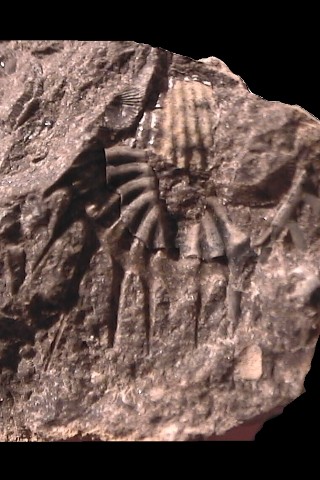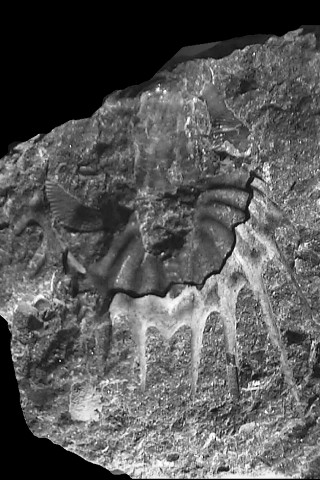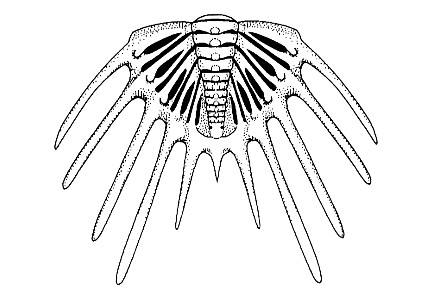
Specimen description :
- Pygidium, both positive and negative part.
- On matrix
- Total size : 18 mm.
- Upper Devonian - Frasnian.
- Belgium.

Heliopyge helios
Heliopyge helios is a very rare Trilobite from the Upper Devovian of Belgium. It has been described with only a few cephalons and some pygidia in Belgium, while in France, there is a "affinity helios" species (MORZADEC 1983), very similar to the belgian form.
Hence, this is not really a surprise if I can only show you a pygidium of this Asteropygid. Moreover, I don't know if a complete speciment has already been found.
 |
Specimen description :
|
 |
Diagnosis :
|
Order
|
Phacopida
|
SALTER 1864
|
Occurrence: Lower Ordovician (Tremadoc) to Upper Devonian (Famennian).
|
|
Sub-order
|
Phacopina
|
STRUVE 1959
|
|
|
Super-family
|
Acastoiedea
|
DELO 1935
|
|
|
Family
|
Acastidae
|
EDGECOMBE 1993
|
|
|
Sub-family |
Asteropyginae |
DELO 1935 |
Traditionnally included in the Dalmanitidae, Asteropyginae are now included in the Acastids. Mostly benthic trilobites.
|
|
Genera
|
Heliopyge
|
HAAS & MENSINK 1970
|
this genus differs from Neocalminia
PILLET 1969 (at the creation of Heliopyge, it was initially a
subgenus from Neocalminia) mostly by :
|
|
Species
|
helios
|
RICHTER & RICHTER 1926
|
|
Complementary pictures :
 |
 |
|
Same piture, in B&W.
|
Same piture, in B&W.
|
 |
|
Precisions and remarks :
- Heliopyge helios of Belgium has a synchron form in Brittany, France : Heliopyge n. sp. aff. helios Morzadec 1983. It has been described only by a few pygidia, rare and very compressed.
- The differenciation of the Heliopyge species is mostly made by the pygidium, due to the variation of the marginal spines. In Creuzon, Brittany, there are 2 subspecies that can be found on the same collecting site : H. renaudae MORZADEC 1969 and H. troaonensis MORZADEC 1983. The lateral marginal spines are slightly bent and longer for H. renaudae, with its cephalon being ogival and bearing larger visual surfaces.
- LIEBERMAN & KLOC (1997) proposed, on cladistic analysis criteria, to revise some species of Heliopyge in Hallandclarkeops LIEBERMAN & KLOC 1997 (notably Heliopyge troaonensis MORZADEC 1969) due to the text. fig. P. MORZADEC made of it . This revision is not considered as valid here, as the study if the holotype seems necessary to propose a definitive conclusion.
References :
LIEBERMAN B. & KLOC G. 1997. Evolutionary and biogeographic patterns in the Asteropyginae (Trilobita, Devonian) DELO 1935. Bull. Am. Mus. Nat. Hist. 232 : pp. 1 - 127.
MORZADEC P. 1969. Le dévonien de la rive nord de la rivière Faou (Finistère). Etude stratigraphique, étude des trilobites. Bull. Soc. géol. minér. Bretagne, 1968 : pp. 1 - 58. Rennes.
MORZADEC P. 1983. Trilobites du Dévonien (Emsien-Famennien) de la Rade de Brest (Massif Armoricain). Paleontograph. Abt. A 181 (4 - 6) : pp 103 - 184.